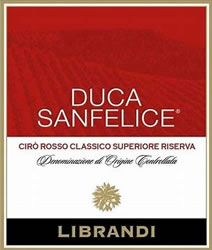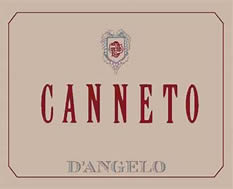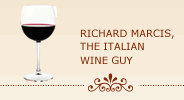Top Winemakers of calabria and Basilicata and Their Flagship Wines
Wines from southern Italy – Basilicata and Calabria in particular - have historically been overlooked in favor of wines from better-known and popular northern wine regions such as Tuscany, Piedmont and Veneto.
This, despite the fact that southern Italy is considered the birthplace of Italian wines and has a rich winemaking tradition. With its warm Mediterranean climate, varied topography, rich volcanic soil and abundance of ancient native grape varieties, vineyards have dotted southern Italy’s landscape for thousands of years and its wines were much prized by ancient Greeks and Romans.
However, for most of modern history, southern Italy’s wine industry has languished in obscurity. While the southern regions didn't lack for wine, the vast majority of it was of middling quality produced primarily for local consumption or shipped north for use as a blending wine.
However, some producers - such as Paternoster in Basilicata and Librandi and Ippolito in Calabria – were willing to buck the prevailing “anything goes” winemaking tradition and turn out some fine, age-worthy and distinctive wines. Their pioneering initiatives in the last decades of the 20th century may be thought of as the beginning of southern Italy’s winemaking renaissance.
The market’s endorsement of wines from these progressive, quality-oriented winemakers has spurred a new generation of winemakers trained in modern viticultural and state-of-the-art cellaring procedures and they set about raising the quality bar in order to help realize Calabria’s and Basilicata’s winemaking potential.
Some of the “new-wave” producers integrated modern winemaking practices with native grape varieties to turn out wines with a modern flair yet with a distinctly southern character and sense-of-place. Others experimented with international varieties like Cabernet Sauvignon and Chardonnay to good effect.
All these initiatives have reinvigorated the wine scene in Calabria and Basilicata and raised the stature of their wines in foreign markets. But this wine revolution is still a work in progress and the best from these determined and enterprising regions is yet to be realized.
Listed below are some of the top-rated producers from the Basilicata and Calabria regions with reviews of their flagship wines. However, a caveat is in order. A prerequisite for consideration for the top producers list is that the winery must have a presence in the U.S. market. Some top-notch producers, like Luigi Viola and Roberto Ceraudo from Calabria and the Terre degli Svevi Re Manfredi winery and the Piccin family at Grifalco delle Lucania in Basilicata, do not ship to the U.S. and so were not considered for inclusion in the list of top winemakers.
While all the wines reviewed are available in the U.S., some may be more difficult to find than others but are certainly worth looking for. In that case, the key is to find a knowledgeable wine retailer willing to help you track down the really good stuff.
The wines are listed in alphabetical order by producer within region.
Calabria
Calabria is located in the “toe” of the geographic “boot” that comprises the Italian peninsula. Calabria has a rich winemaking history dating back to the time of the ancient Greeks and Romans. But its winemaking tradition has gradually eroded over time and Calabria’s output of wine today is one of the smallest in Italy.
Calabria is marked with significant variations in micro-climates ranging from the low, sunny hills along the Ionian and Tyrrhenian seacoasts to the cool-climate heights of the mountainous interior.
Approximately 75 percent of Calabria’s wine production is red and the majority of that is made with the local favorite Gaglioppo (gahl yope’ poh) variety which is of Greek origin. Calabria’s best-known wine producing area is the Cirò DOC. Cirò is a fairly large and differentiated DOC region that includes the low-lying hills along the eastern seacoast as well as the steep hillsides leading up to the mountainous interior. For this reason, wines from the Cirò DOC can vary markedly from one vineyard area to another.
Lately, Cirò and other Calabrian DOC’s have taken on a contemporary look as a new generation of winemakers has taken over the helms of their family estates. Using modern winemaking procedures and cellaring practices while still focusing on native varieties such as Gaglioppo, they are giving a fresher vibe to the region’s winemaking image as they shepherd their family estates into the future.
The following are some of Calabria’s best wineries accompanied by descriptions of their most noteworthy wines.
iGreco Winery
iGreco is a small, family owned and operated, organic-certified farm that has for generations been known primarily for its olive oil production. But in recent years the Greco family has been paying increased attention to its vineyards and winery operations and have achieved a well-earned reputation as a producer of high-quality wines.
The winery is located in Cariati on Calabria’s Ionian coast in the Cirò zone. It’s vineyards stretch up the hilly coastline where they grow primarily Gaglioppo as well as some other red and white varieties such as Nero d’Avola (known locally as Calabrese) and Greco. iGreco’s high elevation vineyards experience good daytime-night time temperature variations that allow the grapes to ripen slowly, develop aromatic complexity and preserve natural acidity.
iGreco, “Catà” Gaglioppo Rosso Calabria IGT 2016 (about $20)
iGreco’s Catà is produced entirely with Gaglioppo from the Cirò zone. The grapes are fermented in stainless steel, aged for 6 months in French oak barriques and spends a few additional months in the bottle prior to release.
The Cata Gaglioppo Rosso is a medium-bodied but deeply flavored wine with fruity red berry and spice notes, soft tannins and excellent balance of acidity and fruit. This pure Gaglioppo effortlessly fuses richness with finesse.
Ippolito 1845
Founded in 1845, Azienda Ippolito is the oldest winery in Calabria. Located in the seaside town of Ciro Marina on Calabria’s Ionian coast, this 250-acre estate produces a number of red and white wines made with primarily indigenous varieties such as Gaglioppo, Calabrese and Greco Bianco, among others. Although Ippolito flies under the radar of most wine buyers, it produces some outstanding wines and is just now starting to get some of the international acclaim it rightly deserves.
Ippolito 1845, “Ripo del Falco” Cirò Rosso Classico Superiore Riserva 2010 (about $45)
Ippolito’s 2010 Ripe del Falco Cirò Rosso Riserva is made entirely of Gaglioppo grapes from 40+ year-old vines from the oldest and highest parts of the estate’s Mancuso vineyard. The grapes are harvested in late October - which is pretty late for this part of Italy - so the fruit is fully ripe when harvested. The grapes undergo cold soaking for 2 weeks in order to extract color and flavor from the grape skins.
The wine has an extended ageing regimen. It spends 2 years in large-format oak casks followed by 5-6 years in stainless steel and an additional year in the bottle prior to release for sale. The wine clocks in with an invigorating 15 percent alcohol.
The 2010 Ripo del Falco is a substantial, layered and complex wine. The mouthfeel is full, rich and intense with plenty of grip and capped by a long, flavorful finish.
Librandi
Librandi is probably Calabria’s most recognized and celebrated winery and has worked hard to put Calabria on the world’s wine map. Some of its wines, such as its Duca San Felice Rosso Riserva and Magno Megonio Rosso, have garnered international acclaim and recognition.
The estate has approximately 580 acres planted with indigenous varietals like Gaglioppo and Mantonico as well as some popular international varieties such as Cabernet Sauvignon and Chardonnay.
Librandi, “Duca San Felice” Ciro Rosso Classico Riserva 2015 (about $17)
This wine is made entirely of Gaglioppo from the est ate’s vineyards. The grapes are fermented in temperature-controlled steel tanks and the wine aged in steel vats for 3 years followed by a few months in the bottle prior to release.
ate’s vineyards. The grapes are fermented in temperature-controlled steel tanks and the wine aged in steel vats for 3 years followed by a few months in the bottle prior to release.
The Duca Sanfelice Riserva is medium to full-bodied and softly textured with rich fruit flavors of ripe dark cherries and a flavorful finish accented with some sweet spice notes. It is a serious wine with good ageing potential and a remarkably appealing price.
Librandi, “Gravello” Val di Neto Rosso 2016 (about $27)
This wine is a blend of 60 percent Gaglioppo from Librandi’s Val di Neto vineyard and 40 percent Cabernet Sauvignon. After fermentation in temperature-controlled stainless-steel tanks, the wine is aged in small oak barrels (barriques) for 12 months and then spends an additional 6 months in the bottle prior to release.
The wine is deep red in color with purple edges and generous aromas of prunes, plums and kitchen spices. It is full-bodied, well-structured with firm tannins and a nice combination of dark cherry flavors and earthy notes. It’s a gorgeous wine that goes well with flavorful foods or simply sipped by itself.
It’s worth noting that in 2019 Gambero Rosso recognized this wine as one of Italy’s best with a Tre Bicchieri (“3 glasses”) award.
Odoardi
The Odoardi family has owned land on Calabria’s hilly, western coast on the Tyrrhenian Sea for centuries. While they have a long wine-making history, their modern winemaking story begins in the early 1990’s when two Odoardi brothers, Gregorio and Giovan Battista, began making some expressive wines from native varieties that began to make a mark on the international stage.
Odoardi has 175 acres under vine with vineyards that scamper up the steep hillside and that range from sea level to about 2,000 feet asl. The hilly terrain and sea breezes help moderate the excessive heat in this typically hot and arid region. They produce a small number of wines made with Gaglioppo and some other traditional local varieties.
Savuto is a small DOC on Calabria’s western coast that covers production of red, white and rosato wines. Red wines from the Savuto DOC are blended wines where Gaglioppo and Aglianico play starring roles.
Odoardi, Savuto DOC 2015 (about $16)
Odoardi’s 2015 Savuto is a blend of 45 percent Gaglioppo and 25 percent Aglianico with the remaining 30 percent consisting of 3 other native red varieties. The wine is fermented and aged in steel tanks for 4 months and spends 3 months in the bottle prior to release.
The wine is medium to full-bodied with fragrant, earthy aromas and pronounced blackberry and plum flavors, smooth tannins and a long finish with some trailing spice notes.
Statti
Statti is a family-owned and operated winery that traces its history back to the late 18th century. Today, it is managed by brothers Antonio and Alberto Statti who have updated vineyard management practices and cellaring procedures.
The estate has 250 acres under vine allocated primarily to indigenous varieties such as Gaglioppo, Greco Nero and Mantonico. It offers a broad portfolio of wines that includes several sparkling wines as well as a dessert-style passito wine.
Statti, Gaglioppo 2018 (about $16)
This offering from Statti is made entirely of Gaglioppo from the estate’s vineyards. The grapes are fermented at  controlled temperatures for 7 days and then aged in stainless steel tanks for 3 months with a few additional months in the bottle prior to release. It has 13 percent alcohol.
controlled temperatures for 7 days and then aged in stainless steel tanks for 3 months with a few additional months in the bottle prior to release. It has 13 percent alcohol.
This medium-weight, food-friendly wine has intense aromas of ripe cherries with attractive juicy fruit and red berry flavors. It has a round and soft texture but there is a good sense of structure and some spice notes that give lift to the long, fruity finish.
Basilicata
To locals, Basilicata is known by another name: Lucania, the ancient Roman name for the region. Located in the lower middle portion of the Italian peninsula (in the “arch” of the “boot” that comprises geographic Italy), Basilicata is marked by a rugged terrain that culminates in the Apennine mountains on its western border.
When it comes to wine, Basilicata's acknowledged leader is Aglianico(ahl yan’ ee koh), one of southern Italy’s finest wines and one that is rapidly gaining international admirers. It’s a dry, robust and long-lived red wine that accounts for approximately one-half of the region’s total vineyard acreage and essentially is the region’s only exported wine.
The wine is made entirely of the austere, acidic and tannic Aglianico variety. Aglianico loves volcanic soil so it finds its best expression in the northwestern corner of the region on the hilly slopes of the extinct volcano, Monte Vulture. Aglianico wines from this area qualify for Aglianico del Vulture DOC status.
Aglianico requires some significant ageing for the wine’s considerable tannins to soften and its aromas and flavors to evolve. Basic Aglianico del Vulture DOC must age for a minimum of one year at the winery; Superiore DOCG must age for a minimum of 3 years; and Riserva DOCG for a minimum of 5 years.
There are some other winegrowing areas in Basilicata, most of which are in the vicinity of the ancient but modern city of Matera. Here, a range of varieties like the red Primitivo, Sangiovese and Cabernet Sauvignon and the white Greco Bianco are used in the production of a host of wines, of which very little finds its way to the export market.
Basilisco
The Basilisco winery was established in 1992 and was acquired in 2010 by the Campania-based Feudi di San Gregorio, one of southern Italy’s premier winery operations. The winery is formally located in a 16th-centurty palace but the winery’s vinification and ageing rooms are located in ancient man-made caves on the slopes of the extinct Monte Vulture volcano.
The estate has several small vineyards that total approximately 45 acres in the Barile area on the southeastern slopes of Monte Vulture. The certified-organic vineyards are about 1,700 feet above sea level. The winery produces a small number of Aglianico del Vulture wines and a white made entirely of the Fiano variety. Each is a cru wine produced with grapes from separate mall vineyard plots.
Basilisco, “Teodosio” Aglianico del Vulture DOC 2014 (about $18)
The estate’s 2014 Teodosio is made entirely of Aglianico grapes harvested from a small 10-acre vineyard. The grapes are macerated and fermented for 25 days in stainless steel tanks and then aged for 15 months in French oak barriques. The wine spends an additional 12 months in the bottle prior to release and has 13.5 percent alcohol.
The wine is full-bodied, rich and textured with ripe black fruit flavors with some spice notes. Even though rich and intense, it doesn’t lose its sense of style and finesse.
Cantine del Notaio
Established in 1998, Cantina del Notaio has over its relatively short life managed to establish an impressive track record as a producer of quality Aglianico del Vulture wines. The estate’s grapes are harvested from 65 acres of vineyards spread over 5 different vineyard sites in the Rionero zone on the eastern slopes of Monte Vulture.
Cantine del Notaio has a large portfolio of red, white and rosato wines along with some dessert, sparkling and fortified wines. However, the flagship wines of the estate are its Aglianico del Vulture wines, especially its La Firma and Il Repertorio bottlings which rank among the very best of the area.
Cantine del Notaio, “La Firma” Aglianico del Vulture 2012 (about $54)
The 2012 La Firma is made entirely of organically-grown, late harvested Aglianico del Vulture grapes. The fully-ripe grapes undergo a long maceration lasting some 25 days. The wine is then aged in new French oak barriques for a year with 4 additional months in the bottle prior to release. It has 14 percent alcohol.
The “La Firma” exhibits complex, mouth-coating flavors of ripe, dark, jammy fruit and cassis, a rich texture and soft, velvety tannins, all grounded by firm acidity. The wine has good ageing potential and, while drinkable now, will continue to evolve and mature over the next decade.
Cantine del Notaio, “Il Repertorio” 2015 (about $44)
With a shorter fermentation period and use of stainless steel tanks, the Il Repertorio is produced in a slightly more traditional way than is the La Firma. The Aglianico grapes are harvested in mid-October and fermented for about 10 days in temperature-controlled stainless steel tanks. The wine is then aged in French oak barriques for 12 months and spends a few additional months in the bottle prior to release. The alcohol is 14 percent.
Il Repertorio is a big and generous wine with an intense aromatic profile that segues into a tsunami of dark fruit flavors. It has a full, rich and intense mouthfeel with firm tannins and a long persistent finish.
Casa Vinicola D’Angelo
The D’Angelo winery is located in Rionero in Vulture on the eastern slope of Monte Vulture. The estate has approximately 87 acres of some of the oldest and most desirable high-elevation vineyards in the area and produces several highly-acclaimed single-vineyard versions of Aglianico.
D’Angelo, “Canneto” Aglianico Basilicata IGT 2015 (about $20)
The estate’s “Canneto” is made entirely of Aglianico grapes harvested from 30 to 40-year-old vines grown in rich volcanic soil. The grapes undergo a 10-day maceration and the wine is aged in barriques for 18  months with an additional 8 months in bottle prior to release for sale.
months with an additional 8 months in bottle prior to release for sale.
The 2015 “Canneto” has a ruby tending to brick red color. It is full-bodied with mouth-drying tannins, good acidity, and an enticing blend of black fruit flavors with some black pepper notes and has the stuffing to age gracefully for another decade or more.
D'Angelo, “Valle del Noce” Aglianico del Vulture 2013 (about $45)
The Aglianico grapes for the Valle del Noce come from a relatively small 18-acre vineyard that lies about 1,200 feet above sea level. The grapes undergo a 10-day fermentation and are then aged for about 18 months in large-format oak casks with a few additional months in the bottle prior to release. Alcohol is 14 percent.
It’s a big, robust wine with mouth-drying tannins, high acidity, an enticing blend of blackberry and ripe cherry flavors and a long, pleasing finish. The wine’s assertive tannins, ripe dark fruit flavors and vibrant acidity showcases its Aglianico pedigree.
Paternoster
The Paternoster winery is generally considered one of the region’s most important wineries. Located in Barile on the eastern slope of Mount Vulture, the estate has approximately 50 acres of rich, black soil vineyards of volcanic origin that includes the highly-regarded Don Anselmo and Rotondo vineyards.
Paternoster has a small portfolio of red, white, rosè and even some sparkling wines. All of its reds are based on the Aglianico variety while the whites include a variety of southern Italy’s indigenous varieties such as Fiano and Falanghina. The winery follows organic and eco-sustainable practices and procedures. Paternoster recently joined the Tommasi Family Estates wine consortium whose headquarters is in Verona in the Veneto region.
Paternoster, “Don Anselmo” Aglianico del Vulture 2015 (about $62)
Don Anselmo is Paternoster’s flagship bottling, made entirely from Aglianico grapes from the estate’s small, old-vine Don Anselmo vineyard that is named after the winery's founder, Don Anselmo Paternoster.
After fermentation, half the wine is aged large-format oak casks and the other half in French oak barriques. After blending, the wine is aged for an additional year in the bottle prior to release. It has 14 percent alcohol.
It is a full-bodied and sturdy but still elegant wine generally recognized as one of Basilicata’s best. While the wine is ready to drink now, it has good ageing potential and will, if you have the patience, age gracefully for at least 8 to 10 more years.
While I don’t like to name-drop, it’s worth noting that the 2015 Don Anselmo was the recipient of Gambero Rosso’s prestigious Tre Bicchieri award in 2019.
Paternoster, “Rotondo” Aglianico del Vulture 2012 (about $50)
The Rotondo is made entirely of Aglianico grapes from the estate’s small, low-yield Villa Rotondo vineyard that lies approximately 1,700 feet above sea level.
The grapes are fermented on the skins in stainless steel tanks for 10 days, aged in French oak barriques for 14 months with 12 months in the bottle prior to release. The alcohol is 14 percent.
The high elevation, single-vineyard Rotondo is rich and intense with dark fruit aromas and flavors but somewhat smoother and less austere than the estate’s Don Anselmo Aglianico. This wine is ready to drink now and would be an ideal companion at any dinner where grilled red meats, lamb, meat-based pasta dishes or aged cheeses are on the menu.
Elena Fucci
The Elena Fucci winery is located in the commune of Barile in the heart of the Aglianico production zone. The estate consists of a single, 15-acre, organically-farmed vineyard planted exclusively with Aglianico grapes used solely for the production of Titolo, the estate’s only wine.
This first-class, high quality cru wine is a serial recipient of Gambero Rosso’s prestigious Tre Bicchieri award. With Titolo’s limited production and high demand from wine enthusiasts around the world it has achieved the wine world equivalent of rock-star status. The estate also bottles a much-in-demand Superior DOCG version of Titolo with a bottle price tag well north of $100.
Elena Fucci, “Titolo” Aglianico del Vulture 2015 (about $34)
The grapes are harvested over a two-week perio d from late October to early November and fermented in stainless steel tanks at controlled temperatures. The wine is aged for 12 months in new and second passage French oak barriques and receives an additional 12 months ageing in the bottle before release to the market. The alcohol is 14 percent.
d from late October to early November and fermented in stainless steel tanks at controlled temperatures. The wine is aged for 12 months in new and second passage French oak barriques and receives an additional 12 months ageing in the bottle before release to the market. The alcohol is 14 percent.
The single-vineyard, late-harvested Titolo is rich and intense yet remarkably refined. There are no rough edges here, just juicy black fruit flavors with balsamic notes, a dense texture and a silky tannic weave.
Return to Wine Reviews and Musings
Help keep this website ad-free and independent.
Consider making a contribution to support the work of WineWordsWisdom.com.



